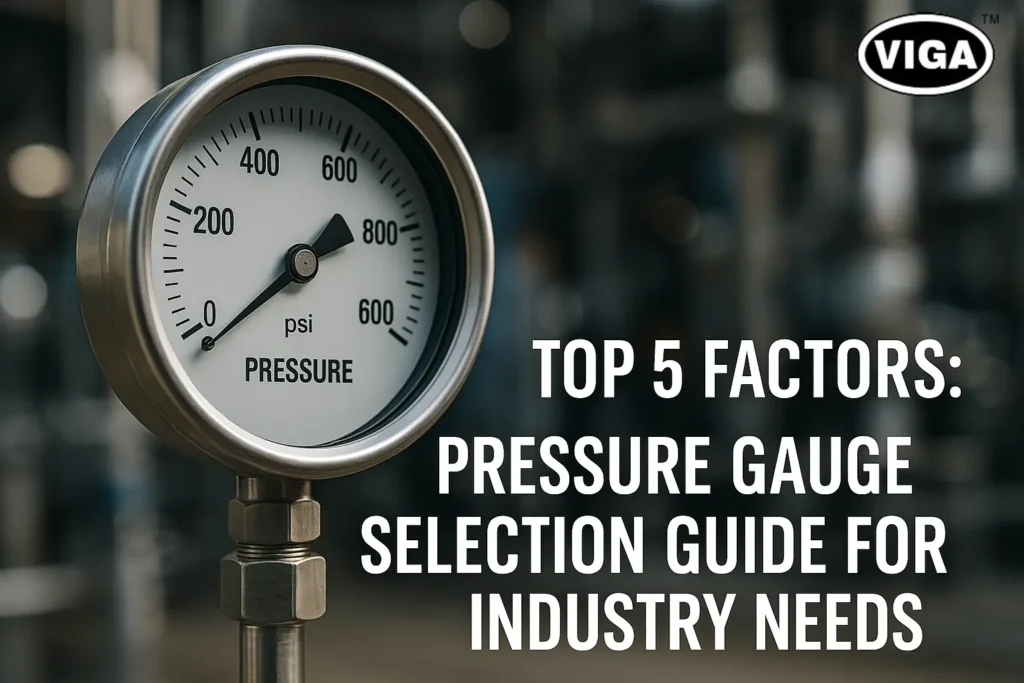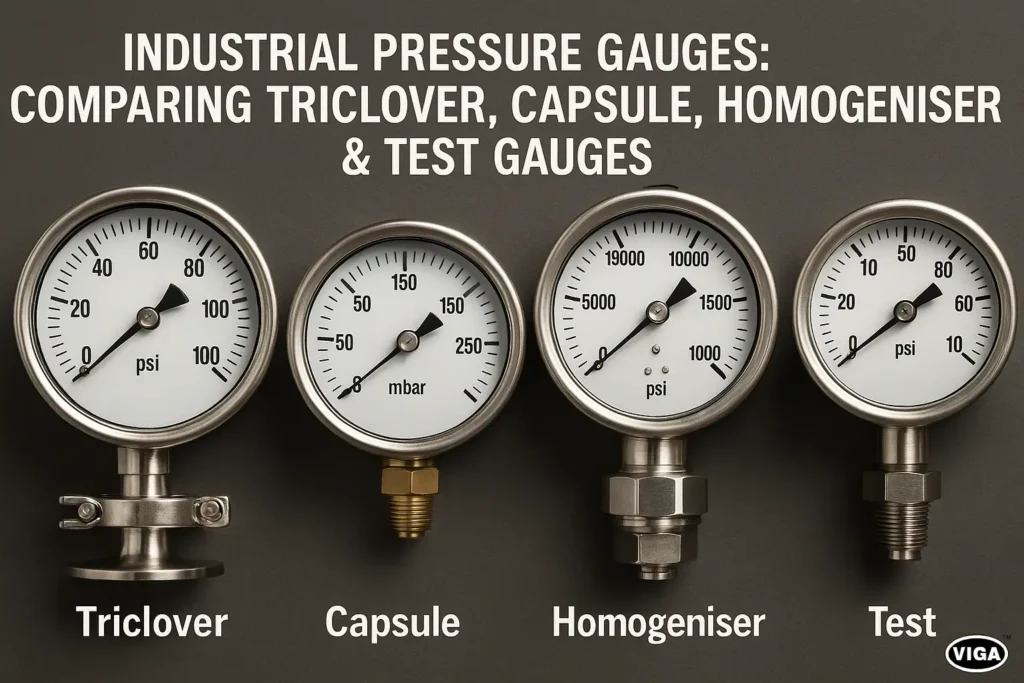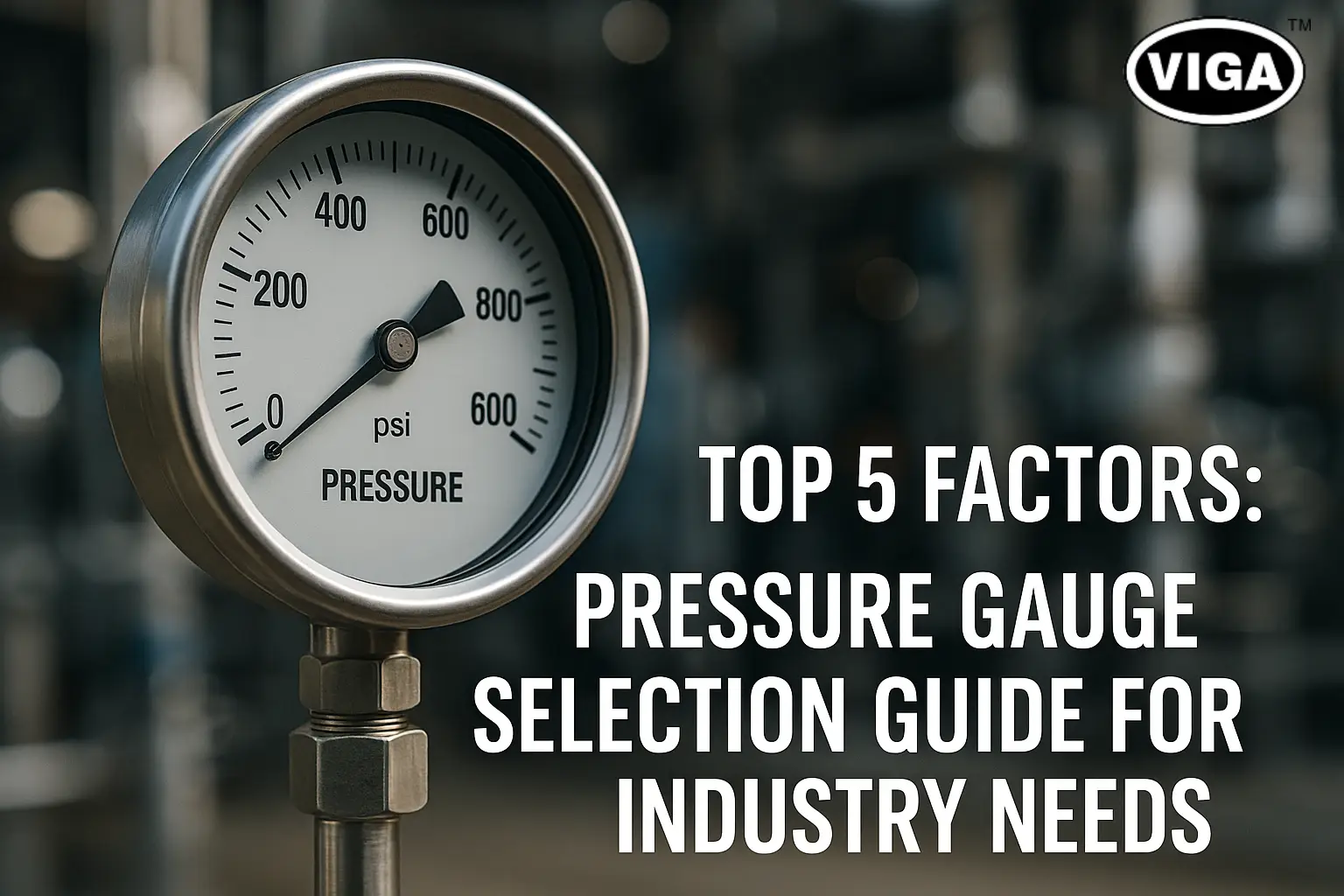
Top 5 Factors: Pressure Gauge Selection Guide for Industry Needs
Top 5 Factors to Consider Before Selecting a Pressure Gauge for Your Industry
Accurate pressure measurement is more than just a metric; it is the cornerstone of safety, quality control, and operational efficiency across every major industry. In critical environments, from refining crude oil to manufacturing pharmaceuticals, a malfunctioning or improperly chosen pressure gauge can lead to disastrous equipment failure, significant downtime, or even hazardous safety incidents.
When selecting instrumentation for industrial process monitoring, choosing a pressure gauge often seems straightforward—but it shouldn’t be a hurried, box-ticking exercise. The nuances of your specific application demand a careful, methodical approach. This detailed Industrial Pressure Gauge Selection Guide outlines the top five factors that must influence your decision, ensuring you choose an instrument that provides reliability and precision for years to come.
What Is Pressure Gauge Selection & Why It Matters
Pressure gauge selection is the strategic process of evaluating a system’s requirements (media type, pressure range, environment) against a gauge’s specifications (accuracy, material, type) to achieve optimal performance, safety, and longevity.
We commonly encounter pressure gauges in various sectors: regulating gas lines in chemical manufacturing, monitoring sterilization chambers in pharma, measuring wellhead pressure in oil & gas, or maintaining quality control in the food and beverage industry.
A wrong selection can have severe consequences. For example, selecting a gauge with poor pressure gauge material compatibility for an abrasive chemical could lead to rapid internal corrosion, causing media leaks, costly equipment downtime, and, potentially, equipment rupture. Learning how to choose a pressure gauge correctly, therefore, is essential to protect assets and personnel.
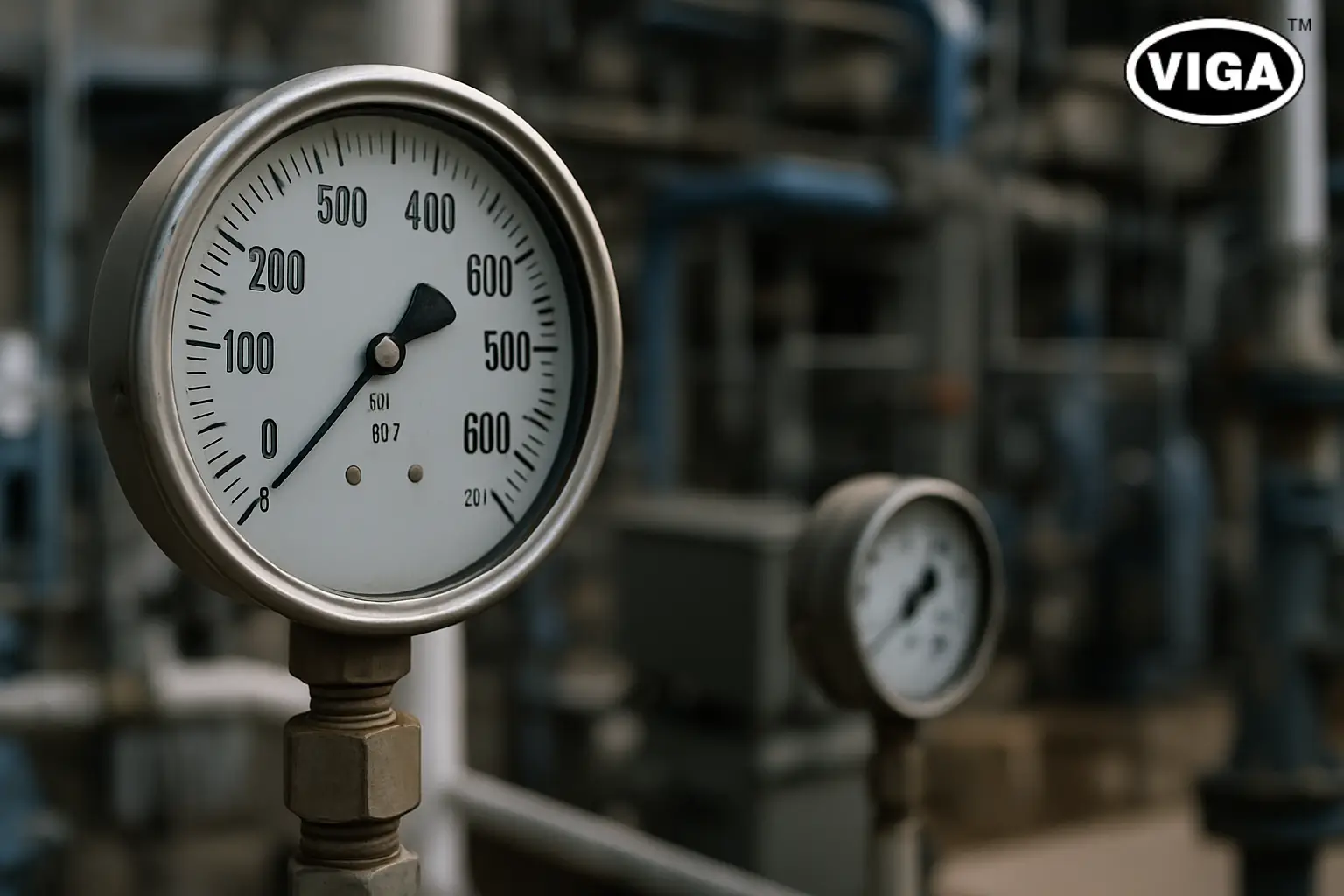
The Top 5 Critical Factors
Factor 1: Pressure Range & Measurement Accuracy
This is perhaps the most fundamental factor in pressure gauge selection criteria. Misjudging the operational pressure range can destroy the gauge rapidly or render its readings meaningless.
The Golden Rule for Range Selection:
The normal working pressure of your system should fall between 40% and 75% of the full-scale range (FSR) of the selected gauge.
- Example: If your typical operating pressure is 400 psi, your chosen gauge should have an FSR of approximately 600 psi to 1000 psi.
- Why 75% is the recommended limit: Constantly operating a gauge above 75% FSR significantly reduces the lifespan and negatively impacts its calibration due to over-stressing internal components.
Measurement Accuracy:
The accuracy class determines how closely the reading represents the true pressure. For standard industrial use, an accuracy class of ±1%±1% is typical. However, for critical monitoring and calibration standards, ±0.5%±0.5% or even ±0.25%±0.25% accuracy is crucial. Higher accuracy translates to better control and safety, justifying a higher investment.
Factor 2: Process Media & Material Compatibility
The medium the gauge is monitoring (the process fluid or gas) is a major determinant of material choice. This step is about preventing premature gauge failure and protecting against contamination.
Process Medium | Common Compatibility Issues | Recommended Materials |
Water, Air, Oil | Standard conditions | Brass or Bronze |
Mild Corrosives | Chemical corrosion | Stainless Steel 304 (SS 304) |
Highly Corrosives (Acids, Ammonia) | Pitting, rapid deterioration | Stainless Steel 316L (SS 316L) or Monel/Hastelloy |
Slurries, Viscous Media | Clogging, buildup | Diaphragm Seals with non-metallic filling |
Failure to ensure gauge material compatibility, especially in chemical and high-purity environments, can be dangerous and extremely costly. Selecting the best pressure gauge for industrial use means first checking the fluid characteristics.
Factor 3: Operating Environment & Application Type
The external conditions surrounding the gauge have a profound impact on its reliability. Neglecting environmental stressors often leads to premature failure, regardless of how accurate the gauge itself is.
- Vibration and Pulsation: Machinery vibration (e.g., near compressors or pumps) can damage the gauge movement (gear train and pointer). For such environments, selecting a liquid-filled pressure gauge (often filled with glycerine or silicone) is essential. The damping fluid stabilizes the pointer, reduces wear on internal gears, and extends the gauge’s lifespan.
- Temperature: Both high ambient temperatures and high process media temperatures must be addressed. High process temperatures require the use of accessories like cooling siphons (for steam) or chemical seals to isolate the gauge from the heat, ensuring the internal components remain within their operational temperature limit.
Factor 4: Gauge Type & Mounting Configuration
Industrial pressure monitoring applications require a variety of gauge types, each suited for a different measurement principle and fluid characteristic.
- Bourdon Tube: Most common, reliable for general process applications.
- Diaphragm/Capsule: Best for low pressures (Draft pressure) and protecting the sensor from clogging fluids (slurries).
- Digital Gauges: Offer high accuracy, readability, and integrated features like data logging and analog output, making them invaluable for precise monitoring and compliance in advanced facilities.
Beyond the type, correctly choosing the pressure gauge size, range, and connection type (e.g., NPT, BSP) and ensuring a correct mounting configuration (panel, surface, or direct line) is key to proper installation and viewing accessibility.
Factor 5: Calibration, Maintenance & Reliability
A gauge is only reliable if its readings can be trusted. Pressure gauge calibration is not just an expense; it’s an insurance policy. Calibration confirms the accuracy of the device against known standards (like ISO/ASME) and is crucial for maintaining compliance and product quality. [Keywords: Pressure Gauge Calibration, Pressure Gauge Reliability]
Industry best practice recommends establishing a recommended calibration interval based on the gauge’s environment, accuracy class, and criticality to the process, usually every 6 to 12 months. Routine checks and preventive maintenance, such as checking for external leaks and ensuring the pointer moves freely, will prevent catastrophic system failures and uphold long-term reliability.
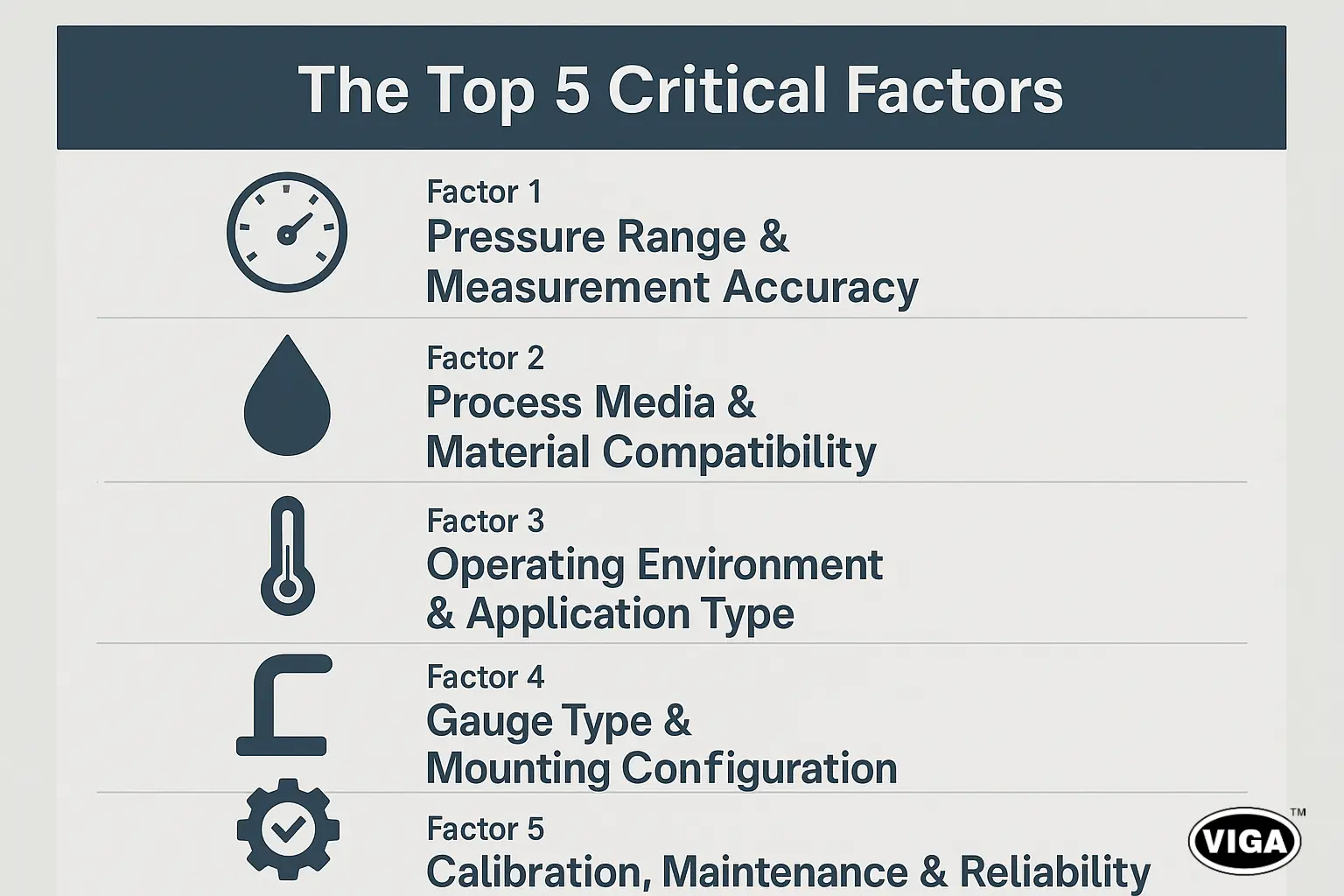
Bonus Tip: Safety Standards & Certifications
When it comes to industrial pressure gauge safety, verify that your gauge complies with established national and international standards such as ASME B40.100 (U.S.) or EN 837 (European). These certifications ensure the instrument meets rigorous safety design requirements, including burst pressure and housing integrity. Always request supplier documentation to confirm traceability and manufacturing quality. [Keywords: Pressure Gauge Standards, Industrial Pressure Gauge Safety]
Common Mistakes to Avoid While Selecting a Pressure Gauge
A clear path to effective pressure measurement often begins with identifying potential pitfalls. The following common mistakes while choosing a pressure gauge should be actively avoided:
- Selecting the wrong range: Always respect the 75% rule (Factor 1). Never use a gauge with a range too close to the system’s maximum working pressure.
- Ignoring Material Compatibility: A cost-saving choice like brass for an aggressive acid application will cost far more in failure and downtime later (Factor 2).
- Skipping the Snubber/Siphon: For dynamic pressures or steam applications, ignoring accessories designed to stabilize the gauge can instantly lead to vibration-induced damage or high-temperature failure (Factor 3).
Neglecting Calibration: Assuming accuracy is permanent after installation is the surest way to operate blind. Regular, certified calibration is essential (Factor 5).
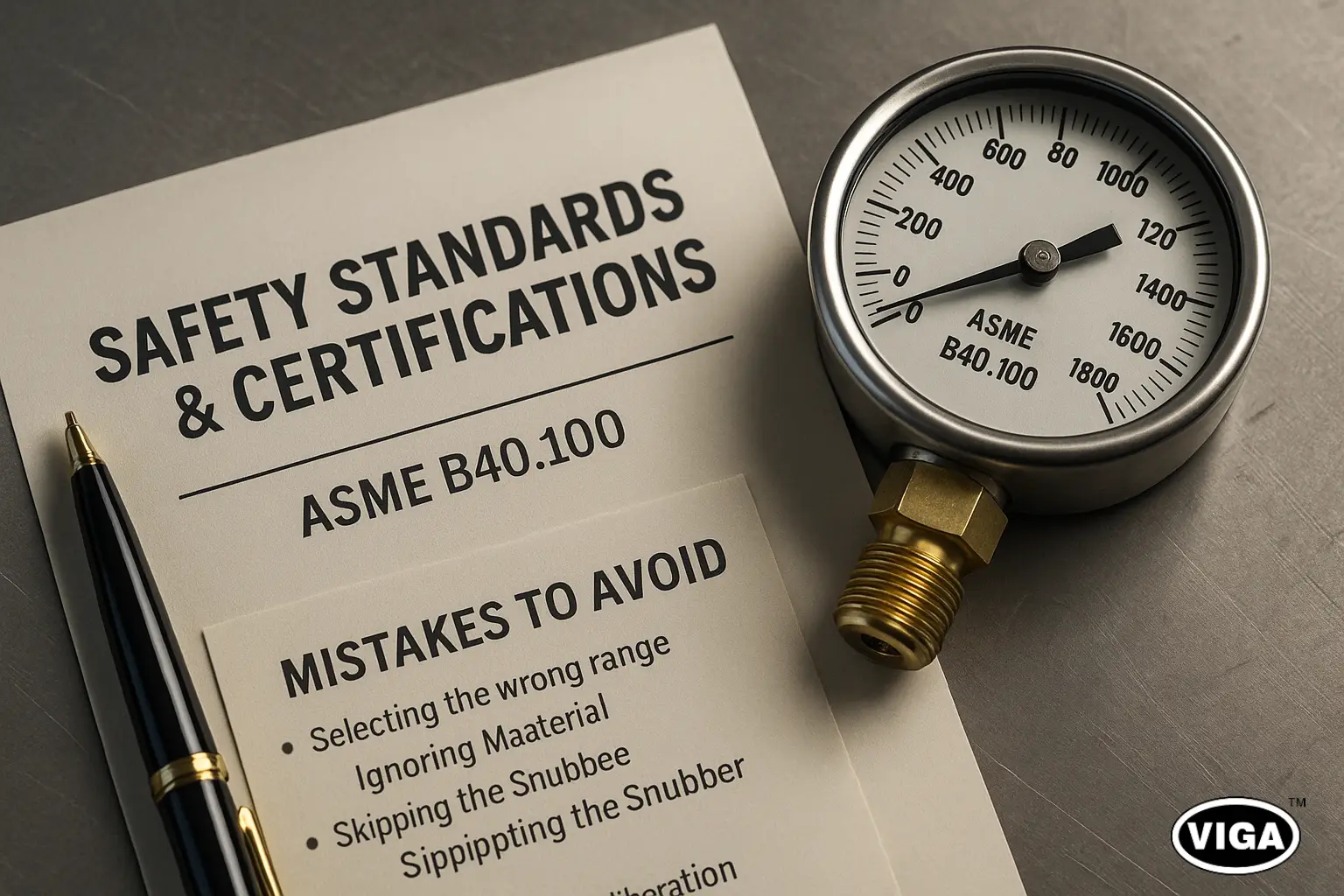
Conclusion
Successful pressure gauge selection requires moving past the price tag and focusing instead on five foundational pillars: the precise pressure range and accuracy needed, comprehensive material compatibility with the process fluid, assessment of the demanding operating environment, choosing the appropriate type and mounting, and planning for ongoing calibration and reliability.
In the intricate landscape of industrial processing, these instruments are silent guardians of your system’s integrity. Taking a strategic, criteria-based approach is the definitive way to secure operational safety, boost efficiency, and choose a solution that genuinely supports your industrial pressure gauge needs. Consult with an instrumentation expert to design the custom gauge solution perfect for your most challenging applications.
FAQs
Q1: What is the most important factor when choosing a pressure gauge?
While all five factors are critical, the most crucial is correctly determining the Pressure Range and Measurement Accuracy. Operating pressure must safely fall within 40% to 75% of the gauge’s full-scale range to ensure maximum reliability and longevity, a key component of the pressure gauge selection criteria.
Q2: How do I know the correct pressure range for my system?
The correct pressure range (full-scale) should be chosen such that your normal operating pressure is never above 75% of the full-scale rating, providing a crucial safety margin against over-pressure events and protecting the integrity of the gauge.
Q3: Why should I calibrate my pressure gauge regularly?
Regular pressure gauge calibration ensures that the instrument’s accuracy remains compliant with established standards (e.g., ASME). It is necessary because external factors like vibration, temperature fluctuations, and usage naturally cause sensor drift over time, which can compromise system safety and quality control.
Q4: What’s the difference between digital and analog pressure gauges?
Analog (Bourdon tube) gauges use a mechanical movement to indicate pressure and are robust for general industrial use. Digital gauges, however, offer superior pressure gauge accuracy, clear numerical displays, data logging features, and high precision for critical monitoring or validation applications.
Q5: Can one pressure gauge be used for multiple applications?
While convenient, it is not recommended. Pressure Gauge Selection should always be application-specific, taking into account factors like the maximum working pressure, required accuracy, and process media type. Using a gauge intended for inert gas on an aggressive chemical could quickly destroy it.


